CIESC Journal ›› 2020, Vol. 71 ›› Issue (2): 746-754.DOI: 10.11949/0438-1157.20191068
• Energy and environmental engineering • Previous Articles Next Articles
Baowei WANG( ),Huijuan SU,Shumei YAO
),Huijuan SU,Shumei YAO
Received:2019-09-23
Revised:2019-11-28
Online:2020-02-05
Published:2020-02-05
Contact:
Baowei WANG
通讯作者:
王保伟
作者简介:王保伟(1971—),男,博士,副教授,基金资助:CLC Number:
Baowei WANG, Huijuan SU, Shumei YAO. Preparation of O3 by O2 DBD microplasma[J]. CIESC Journal, 2020, 71(2): 746-754.
王保伟, 苏会娟, 姚淑美. O2介质阻挡放电微等离子体制备O3[J]. 化工学报, 2020, 71(2): 746-754.
Add to citation manager EndNote|Ris|BibTeX
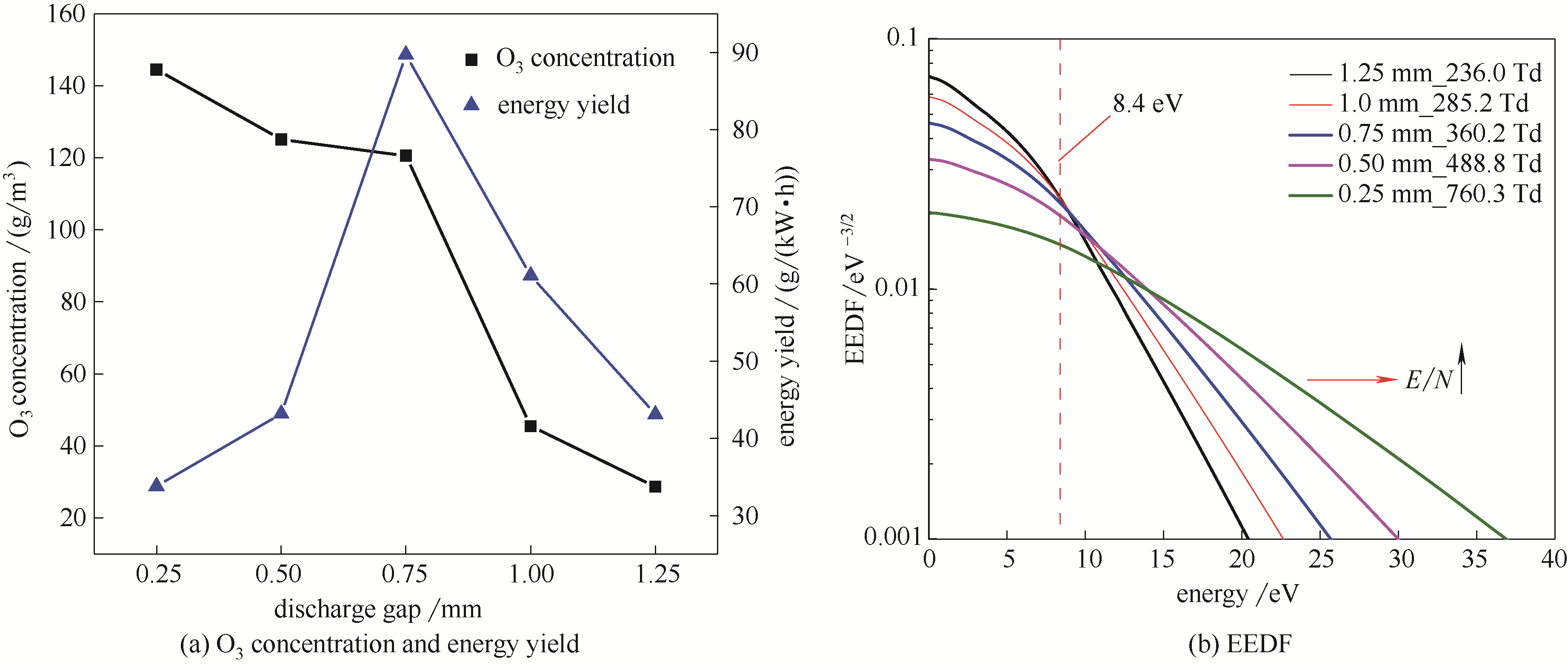
Fig.4 Effect of discharge gap on O3 production performance and electron energy distribution(discharge length: 80 mm; supply frequency: 18 kHz; Pdis: (6.7 ± 0.2) W; residence time: 1.4 s)
| Discharge gap/mm | (E/N)/Td | Mean electron energy/eV |
|---|---|---|
| 0.25 | 760.3 | 16.2 |
| 0.5 | 488.8 | 11.7 |
| 0.75 | 360.2 | 9.38 |
| 1 | 285.2 | 7.93 |
| 1.25 | 236 | 6.96 |
Table 1 E/N and mean electron energy at different discharge gap
| Discharge gap/mm | (E/N)/Td | Mean electron energy/eV |
|---|---|---|
| 0.25 | 760.3 | 16.2 |
| 0.5 | 488.8 | 11.7 |
| 0.75 | 360.2 | 9.38 |
| 1 | 285.2 | 7.93 |
| 1.25 | 236 | 6.96 |
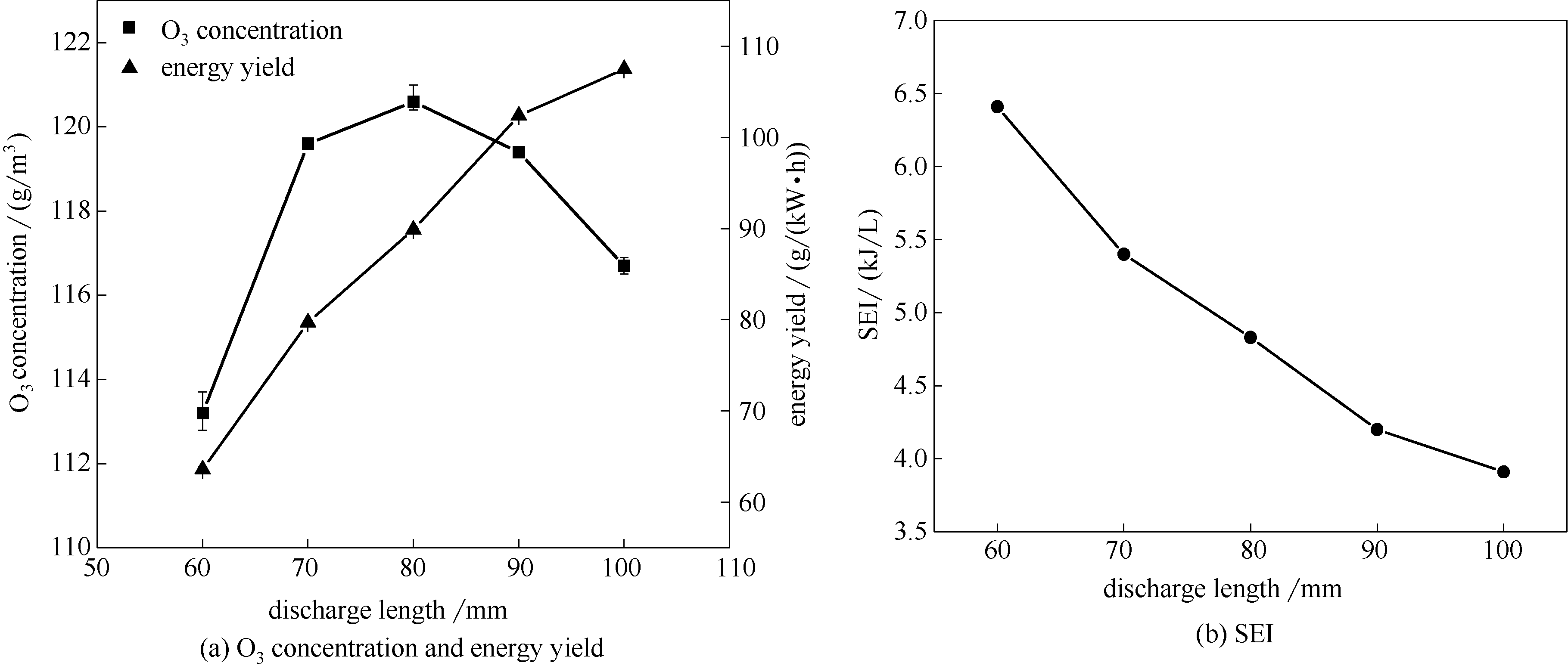
Fig.5 Effect of discharge length on O3 production performance(discharge gap: 0.75 mm; supply frequency: 18 kHz; Pdis: (6.7 ± 0.2) W; residence time: 1.4 s)
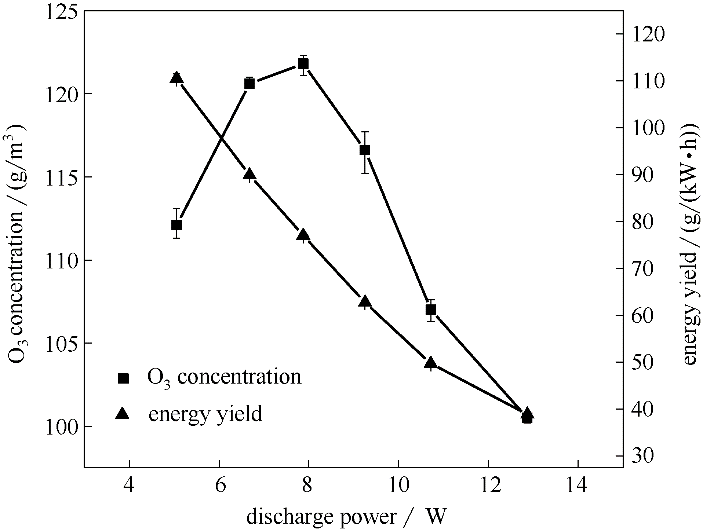
Fig.6 Effect of discharge power on O3 concentration and energy yield (discharge length: 80 mm; discharge gap: 0.75 mm; supply frequency: 18 kHz; residence time: 1.4 s)
| Discharge power/W | (E/N)/Td | Mean electron energy/eV |
|---|---|---|
| 5 | 328.9 | 8.78 |
| 6.7 | 360.2 | 9.38 |
| 7.9 | 383.7 | 9.83 |
| 9.3 | 415 | 10.4 |
| 10.7 | 430.7 | 10.7 |
| 12.9 | 446.3 | 11 |
Table 2 E/N and mean electron energy at different discharge power
| Discharge power/W | (E/N)/Td | Mean electron energy/eV |
|---|---|---|
| 5 | 328.9 | 8.78 |
| 6.7 | 360.2 | 9.38 |
| 7.9 | 383.7 | 9.83 |
| 9.3 | 415 | 10.4 |
| 10.7 | 430.7 | 10.7 |
| 12.9 | 446.3 | 11 |

Fig.7 Effect of discharge power on reactor temperature, SEI and EEDF(discharge length: 80 mm; discharge gap: 0.75 mm; supply frequency: 18 kHz; residence time: 1.4 s)
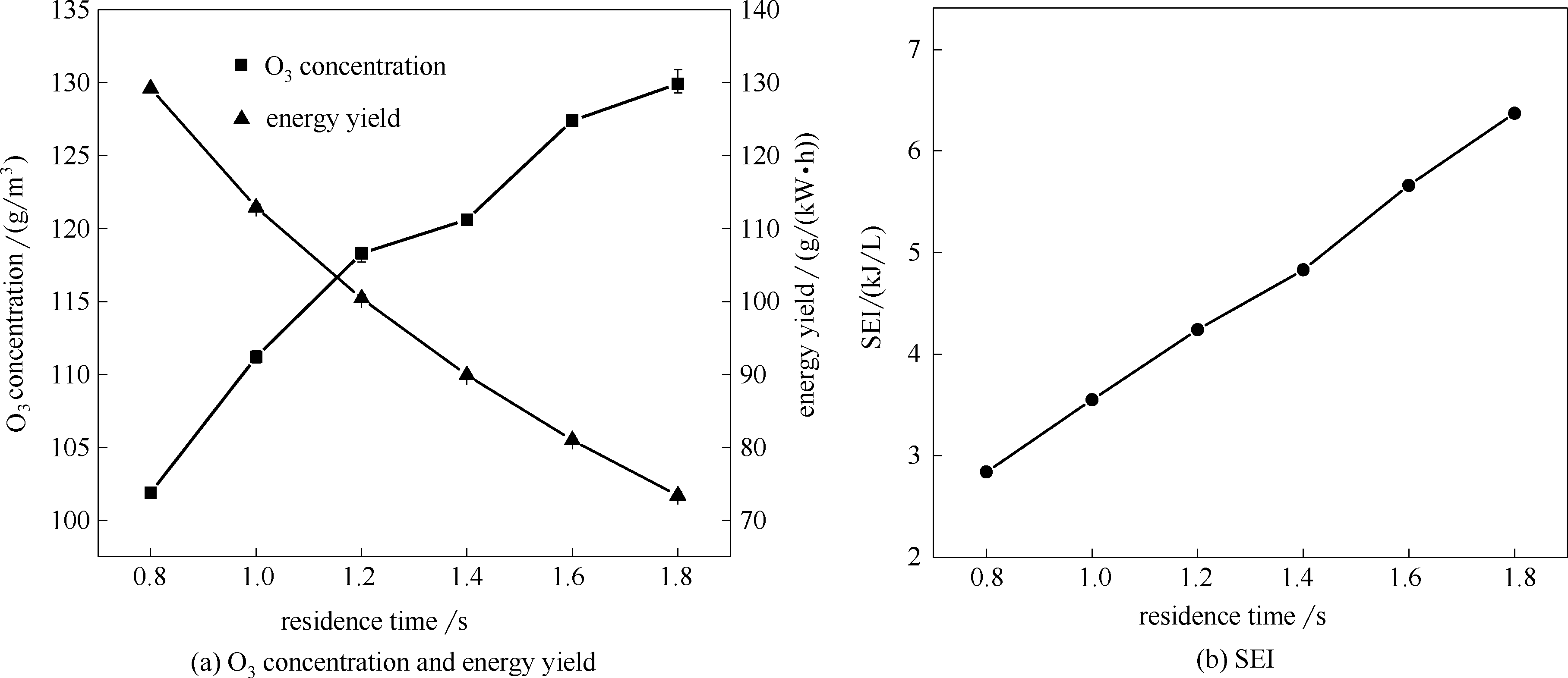
Fig.8 Effect of residence time on O3 production performance concentration and energy yield(discharge gap: 0.75 mm; discharge length: 80 mm; Pdis: (6.7 ± 0.2) W; supply frequency: 18 kHz)
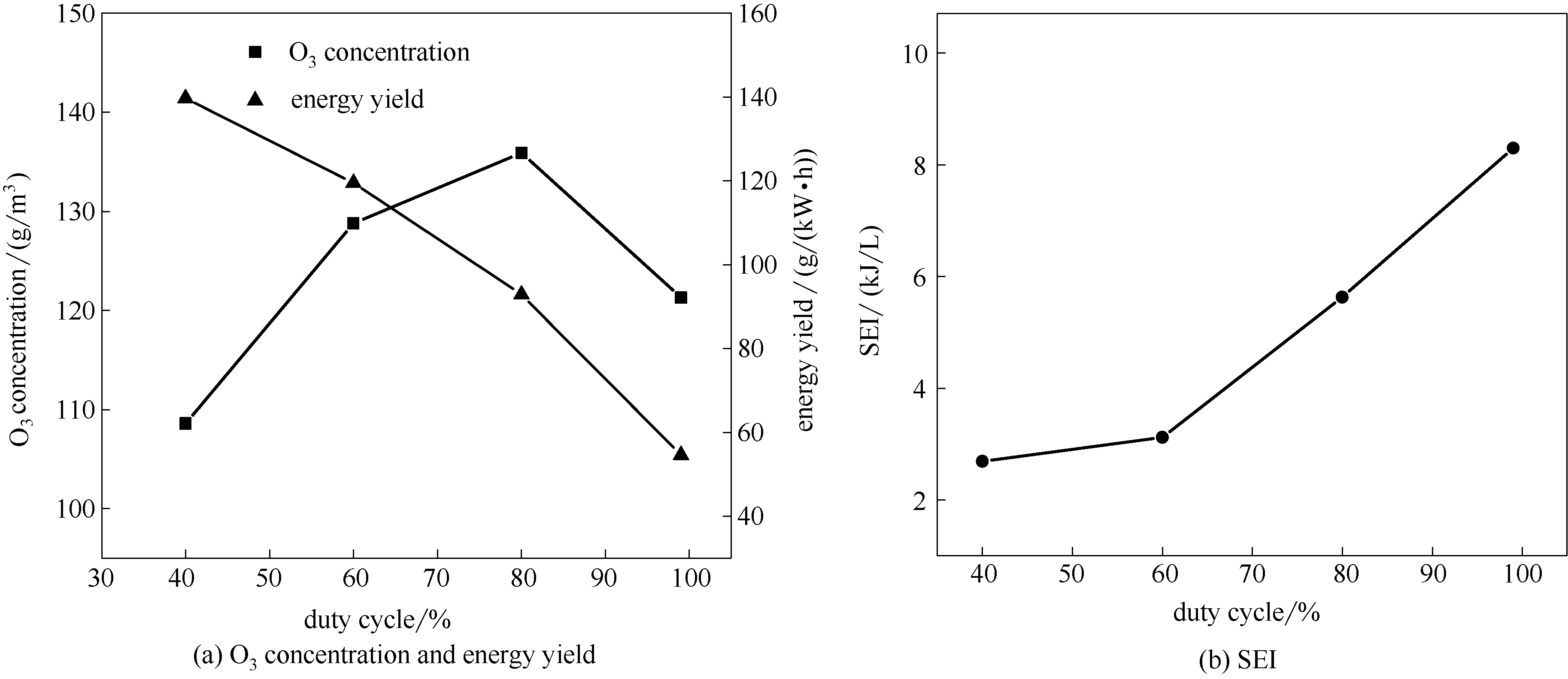
Fig.9 Effect of duty cycle of modulated pulse on O3 generation and SEI (discharge gap: 0.75 mm; discharge length: 80 mm; Pdis: (6.7 ± 0.2) W, residence time: 1.4 s; supply frequency: 18 kHz; modulation frequency: 800 Hz)
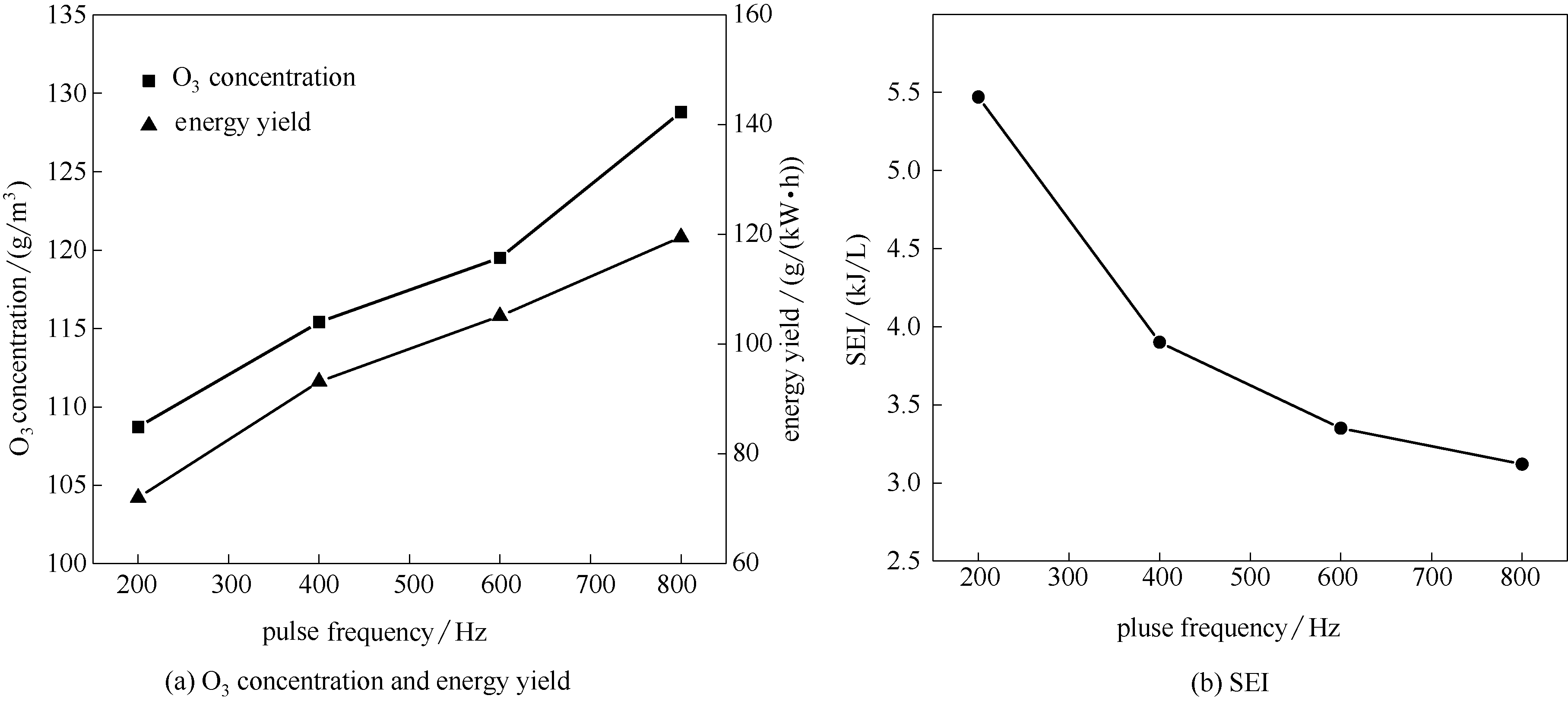
Fig.10 Effect of modulation frequency on O3 generation and SEI(discharge gap: 0.75 mm; discharge length: 80 mm; Pdis: (6.7 ± 0.2) W; residence time: 1.4 s; supply frequency: 18 kHz; duty cycle: 60%)
| 1 | 王保伟, 姚淑美, 彭叶平. 介质阻挡等离子体制备臭氧研究进展[J]. 现代化工, 2018, 38(7): 31-35. |
| Wang B W, Yao S M, Peng Y P. Progress on preparation of ozone by dielectric barrier plasma[J]. Modern Chemical Industry, 2018, 38(7): 31-35. | |
| 2 | Nassour K, Brahami M, Nemmich S, et al. Comparative experimental study between surface and volume DBD ozone generator[J]. Ozone: Science & Engineering, 2015, 38: 70-76. |
| 3 | Jenei I, Kis P, Kiss E. The development of ozone generators with the analysis of the field distribution of the electrode arrangements[J]. Ozone: Science & Engineering, 2007, 29: 215-220. |
| 4 | Zhang X, Lee B J, Hong G I, et al. Ozone production with dielectric barrier discharge-effects of power source and humidity[J]. IEEE Transactions on Plasma Science, 2016, 44(10): 2288-2296. |
| 5 | Wei L S. Dong G P, Zhang Y F,et al. Effect of SF6 on ozone generation using dielectric barrier discharge [J]. High Voltage Engineering, 2013, 39(10): 2520-2525. |
| 6 | 魏林生. 等离子体臭氧产生的实验与理论研究[D]. 杭州: 浙江大学, 2008. |
| Wei L S. Theoretical and experimental research on ozone generation by gas discharge plasma[D].Hangzhou: Zhejiang University, 2008. | |
| 7 | Wei L S, Yuan D, Zhang Y, et al. An analysis of the effect of inert gases on ozone generation using dielectric barrier discharge in oxygen [J]. The European Physical Journal D, 2014, 68(1): 17. |
| 8 | Wei L S, Yuan D, Zhang Y, et al. The effect of inert gases on ozone generation using dielectric barrier discharge in dry air [J]. Ozone: Science & Engineering, 2013, 35(6): 448-455. |
| 9 | Chen H L, Lee H M, Chen S H, et al. Influence of Ar addition on ozone generation in nonthermal plasmas [J]. Plasma Sources Science and Technology, 2010, 19(6): 692-701. |
| 10 | Pekárek S. Asymmetric properties and ozone production of surface dielectric barrier discharge with different electrode configurations [J]. The European Physical Journal D, 2013, 67(5): 94. |
| 11 | Nassour K, Brahami M, Nemmich S, et al. New hybrid surface-volume dielectric barrier discharge reactor for ozone generation [J]. IEEE Transactions on Industry Applications, 2017, 53(3): 2477-2484. |
| 12 | Malik M A, Schoenbach K H, Heller R. Coupled surface dielectric barrier discharge reactor-ozone synthesis and nitric oxide conversion from air [J]. Chemical Engineering Journal, 2014, 256: 222-229. |
| 13 | Chebbah A, Hadjeri S, Nemmich S, et al. Development and experimental analysis of a new “serpentine-shape” surface-DBD ozone generator — comparison with a cylindrical volume-DBD ozone generator [J]. Ozone: Science & Engineering, 2017, 39(3): 209-216. |
| 14 | Andreev V V, Pichugin Y P, Telegin V G, et al. Combined barrier discharge in atmospheric-pressure air [J]. Plasma Physics Reports, 2012, 38(13): 1046-1049. |
| 15 | Jodpimai S, Boonduang S, Limsuwan P. Dielectric barrier discharge ozone generator using aluminum granules electrodes [J]. Journal of Electrostatics, 2015, 74: 108-114. |
| 16 | Gnapowski S, Yamabe C, Ihara S. Ozone generation characteristics of ozonizer with the rotating type electrode [J]. IEEJ Transactions on Fundamentals and Materials, 2008, 128(10): 619-623. |
| 17 | Zhang Z, Bai X, Bai M, et al. An ozone generator of miniaturization and modularization with the narrow discharge gap[J]. Plasma Chemistry and Plasma Processing, 2003, 23(3): 559-568. |
| 18 | 商克峰, 曹晓萌, 王肖静, 等. 高压电极构型对DBD装置放电特性及臭氧生成的影响[J]. 高电压技术, 2016, 42(5): 1394-1400. |
| Shang K F, Cao X M, Wang X J, et al. Effect of high voltage electrode geometry on the discharge characteristics and the ozone generation of a DBD device[J]. High Voltage Engineering, 2016, 42(5): 1394-1400. | |
| 19 | 杨春, 胡兆吉, 魏林生. 放电等离子体臭氧发生技术研究现状与进展[J]. 高压电器, 2010, 46: 78-85. |
| Yang C, Hu Z J, Wei L S. The research development of plasma discharge synthesis technology of ozone [J]. High Voltage Apparatus, 2010, 46: 78-85. | |
| 20 | 周立福, 杨学昌, 陈波, 等. 臭氧发生器用高介电硅橡胶复合材料特性及试验分析[J]. 高电压技术, 2010, 36: 1258-1263. |
| Zhou L F, Yang X C, Chen B, et al. Characteristics and experimental analysis of High-K MVQ functional composites for ozonizer [J]. High Voltage Engineering, 2010, 36: 1258-1263. | |
| 21 | 陈波, 杨学昌, 陶顺忠. 等离子喷涂介质层提升臭氧发生器性能的试验研究[J]. 高电压技术, 2013, 39: 1703-1709. |
| Chen B, Yang X C, Tao S Z. Experimental study on plasma sprayed dielectric layer to improve ozone performance [J]. High Voltage Engineering, 2013, 39: 1703-1709. | |
| 22 | 王健. 催化剂耦合介质阻挡放电制取臭氧的试验和模型研究[D]. 合肥: 中国科学技术大学, 2009. |
| Wang J. Experimental and model study of ozone production via DBDs coupling with catalyst[D].Hefei: University of Science and Technology of China, 2009. | |
| 23 | Pekarek S, Mikes J, Pelikanova I B, et al. Effect of TiO2 on various regions of active electrode on surface dielectric barrier discharge in air [J]. Plasma Chemistry and Plasma Processing, 2016, 36(5): 1187-1200. |
| 24 | Pekárek S. Experimental study of surface dielectric barrier discharge in air and its ozone production [J]. Journal of Physics D: Applied Physics, 2012, 45(7): 075201. |
| 25 | Huang W, Ren T, Xia W. Ozone generation by hybrid discharge combined with catalysis [J]. Ozone: Science & Engineering, 2007, 29(2): 107-112. |
| 26 | Dwivedi C, Toley M A, Dey G R, et al. Ozone generation from argon-oxygen mixtures in presence of different packing materials within dielectric barrier discharge gap [J]. Ozone: Science & Engineering, 2013, 35(2): 134-145. |
| 27 | database Phelps [EB/OL]. 2018-06-04, https: //fr.lxcat.net/data/set_type.php. |
| 28 | Yagi S, Kuzumoto M.Silent discharges in ozonisers and CO2 lasers[J]. Australian Journal of Physics, 1995, 48: 411-418. |
| 29 | Homola T, Pongrác B, Zemánek M, et al. Efficiency of ozone production in coplanar dielectric barrier discharge[J]. Plasma Chemistry and Plasma Processing, 2019, 39: 1227-1242. |
| 30 | 邵涛, 严萍.大气压气体放电及其等离子体应用[M].北京: 科学出版社, 2015. |
| Shao T, Yan P. Atmospheric Pressure Gas Discharge and Its Plasma Application[M]. Beijing: Science Press, 2015. |
| [1] | Xuejin YANG, Jintao YANG, Ping NING, Fang WANG, Xiaoshuang SONG, Lijuan JIA, Jiayu FENG. Research progress in dry purification technology of highly toxic gas PH3 [J]. CIESC Journal, 2023, 74(9): 3742-3755. |
| [2] | Baiyu YANG, Yue KOU, Juntao JIANG, Yali ZHAN, Qinghong WANG, Chunmao CHEN. Chemical conversion of dissolved organic matter in petrochemical spent caustic along a wet air oxidation pretreatment process [J]. CIESC Journal, 2023, 74(9): 3912-3920. |
| [3] | Linzheng WANG, Yubing LU, Ruizhi ZHANG, Yonghao LUO. Analysis on thermal oxidation characteristics of VOCs based on molecular dynamics simulation [J]. CIESC Journal, 2023, 74(8): 3242-3255. |
| [4] | Jintong LI, Shun QIU, Wenshou SUN. Oxalic acid and UV enhanced arsenic leaching from coal in flue gas desulfurization by coal slurry [J]. CIESC Journal, 2023, 74(8): 3522-3532. |
| [5] | Yuyuan ZHENG, Zhiwei GE, Xiangyu HAN, Liang WANG, Haisheng CHEN. Progress and prospect of medium and high temperature thermochemical energy storage of calcium-based materials [J]. CIESC Journal, 2023, 74(8): 3171-3192. |
| [6] | Kaixuan LI, Wei TAN, Manyu ZHANG, Zhihao XU, Xuyu WANG, Hongbing JI. Design of cobalt-nitrogen-carbon/activated carbon rich in zero valent cobalt active site and application of catalytic oxidation of formaldehyde [J]. CIESC Journal, 2023, 74(8): 3342-3352. |
| [7] | Pan LI, Junyang MA, Zhihao CHEN, Li WANG, Yun GUO. Effect of the morphology of Ru/α-MnO2 on NH3-SCO performance [J]. CIESC Journal, 2023, 74(7): 2908-2918. |
| [8] | Wentao WU, Liangyong CHU, Lingjie ZHANG, Weimin TAN, Liming SHEN, Ningzhong BAO. High-efficient preparation of cardanol-based self-healing microcapsules [J]. CIESC Journal, 2023, 74(7): 3103-3115. |
| [9] | Zhilong WANG, Ye YANG, Zhenzhen ZHAO, Tao TIAN, Tong ZHAO, Yahui CUI. Influence of mixing time and sequence on the dispersion properties of the cathode slurry of lithium-ion battery [J]. CIESC Journal, 2023, 74(7): 3127-3138. |
| [10] | Bin LI, Zhenghu XU, Shuang JIANG, Tianyong ZHANG. Clean and efficient synthesis of accelerator CBS by hydrogen peroxide catalytic oxidation method [J]. CIESC Journal, 2023, 74(7): 2919-2925. |
| [11] | Yuming TU, Gaoyan SHAO, Jianjie CHEN, Feng LIU, Shichao TIAN, Zhiyong ZHOU, Zhongqi REN. Advances in the design, synthesis and application of calcium-based catalysts [J]. CIESC Journal, 2023, 74(7): 2717-2734. |
| [12] | Xueyan WEI, Yong QIAN. Experimental study on the low to medium temperature oxidation characteristics and kinetics of micro-size iron powder [J]. CIESC Journal, 2023, 74(6): 2624-2638. |
| [13] | Zhenghao YANG, Zhen HE, Yulong CHANG, Ziheng JIN, Xia JIANG. Research progress in downer fluidized bed reactor for biomass fast pyrolysis [J]. CIESC Journal, 2023, 74(6): 2249-2263. |
| [14] | Xiaowen ZHOU, Jie DU, Zhanguo ZHANG, Guangwen XU. Study on the methane-pulsing reduction characteristics of Fe2O3-Al2O3 oxygen carrier [J]. CIESC Journal, 2023, 74(6): 2611-2623. |
| [15] | Feng ZHU, Kailin CHEN, Xiaofeng HUANG, Yinzhu BAO, Wenbin LI, Jiaxin LIU, Weiqiang WU, Wangwei GAO. Performance study of KOH modified carbide slag for removal of carbonyl sulfide [J]. CIESC Journal, 2023, 74(6): 2668-2679. |
| Viewed | ||||||
|
Full text |
|
|||||
|
Abstract |
|
|||||